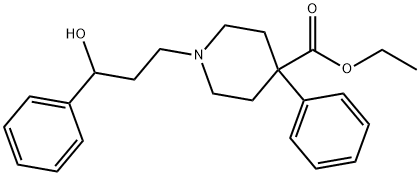Originator
Operidine ,Janssen ,US ,1965
Manufacturing Process
The starting materials for the overall process are phenylacetonitrile with bischloroethyl toluene sulfonyl amide. These react to give a product which hydrolyzes to normeperidine (4-carboethoxy-4-phenylpiperidine). Condensation of that material with benzoylethylene gives the ketone: β-(4carboethoxy-4-phenylpiperidino)propiophenone.
A reaction mixture was prepared containing 4 grams of β-(4-carboethoxy-4phenylpiperidino)-propiophenone hydrochloride, 100 ml of methanol and about 0.5 gram of platinum oxide catalyst. The mixture was placed in a low pressure hydrogenation apparatus and was hydrogenated at a temperature of about 27°C and a pressure of about 3.5 atmospheres of hydrogen to convert the keto group of the β-(4-carboethoxy-4-phenylpiperidino)-propiophenone to a hydroxy group, and to form 3-(4-carboethoxy-4-phenylpiperidino)-1-phenyl-1propanol hydrochloride. After the hydrogenation was complete, the catalyst was separated from the reaction mixture by filtration, and the filtrate was evaporated to dryness in vacuo leaving a residue containing 3-(4carboethoxy-4-phenylpiperidino)-1-phenyl-l-propanol hydrochloride. The residue was digested with ethyl acetate thereby causing 3-(4-carboethoxy-4phenylpiperidino)-1-phenyl-1-propanol hydrochloride to crystallize. This compound melted at about 188°-189°C after being recrystallized three times from an ethyl acetate-methanol solvent mixture, according to US Patent 2,951,080.
